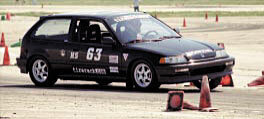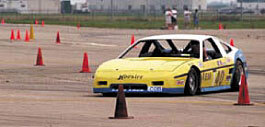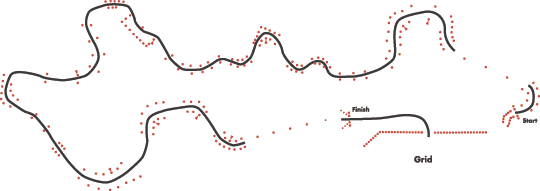by Lloyd Loring, South Bend Region, SCCA
On any summer Sunday, you may see a local parking lot barricaded off, with traffic cones strewn about and cars lined up to drive around (but not over) the bright orange cones as quickly as they can. What you are seeing is an autocross, also called a Solo II when sanctioned by the Sports Car Club of America.
The game is simple: unlike racing, it is the quickest drivers who win, not the fastest. Any licensed driver with a safe car and a helmet may enter for a modest entry fee. But like every other sport there are some rules. The rules are simple, mostly intended to insure safety and fair competition for all drivers. Let’s take a close look at this increasingly popular sport, to see how it works and why it is so attractive to drivers.
Start with the course: a large, unobstructed paved area that permits setting up a miniature road racing course using traffic cones to outline the route. The car must follow the course correctly; each cone knocked down or moved costs two seconds in time penalty. If the driver misses a section of the course the run is not scored at all. Each course is different, and must be approved by a safety steward who checks that there is room for error and there are no obstacles that could hurt either car, driver, or spectators. The event is designed to limit top speed, and most drivers never get above second gear during their run. As a result Solo II is one of the safest automotive sports.
Drivers run alone on the course (hence the name “Solo”) with no wheel-to-wheel racing. On larger courses you may see more than one car on the course at a time, but with cars separated for safety. Each entrant is timed on every run to the nearest 1/1000 second by electronic timers that can handle up to four cars at a time.
The courses are designed to challenge the driving skills and car preparation of the entrants, with turns, slaloms, and gates that put a premium on car control and accurate driving. To take full advantage of the course, most contestants walk the course several times before they run, planning their “lines” and looking for a time advantage wherever they can (there are no practice or qualifying runs prior to the timed runs at a regular Solo II).
A word about the drivers. Generally they are car enthusiasts who enjoy this opportunity to drive hard and smart, and who seek out the chance to compete against other drivers in the sport. They come from every walk of life, and both sexes are represented. Because the sport may be enjoyed at modest cost (tires may be the biggest single expense) it is not limited to an elite group. One unique aspect of autocrossing is the absence of specialized workers and officials. The drivers are also the officials, and are required to work some portion of each event. This cooperation makes autocrossing one of the friendliest forms of auto racing.
You’ll see all kinds of cars at an autocross. And it is obvious that they are not all equal in speed potential. To solve this problem the SCCA has created over 30 car classes in four major groups, with parallel ladies’ classes. Each class runs for its own trophy, although at smaller events the classes may be combined. The five major groups are Stock, Street Prepared, Street Modified/Touring, Prepared, and Modified. Each has its advantages and proponents and they are all hotly contested.

The Stock category is the largest group with 9 classes. Cars are permitted only minor changes from original showroom condition. The stock classes include Super Stock and A Stock through H Stock. Late model Corvettes, Vipers, and Mazda RX-7 Turbos dominate Super Stock, while H Stock contains small economy 4- door sedans, with everything else somewhere in between. The classes cover sedans, sports coupes, all-out sports cars, front- rearor all-wheel drive, and from three to twelve cylinders. In short, the full range of modern street cars is found in the stock group. And because the cars are grouped by actual speed potential, older cars can often remain competitive in the sport.
Very few changes are permitted for stock class cars. Any DOTapproved tires may be used (including tires made specially for autocross use but still street legal.) After-market wheels are OK if they are the same dimensions as stock, the exhaust system may be modified after the catalytic converter, after-market shocks and struts may be substituted, and the air cleaner can be upgraded. But that’s about all. Otherwise, the car must be as-delivered from the showroom floor.
Perhaps a driver has altered the car by using an exhaust header, wider wheels or other minor changes intended to improve handling or speed. This will probably put the car in one of the five Street Prepared classes. This group includes only production cars with limited modifications.
Alternatively, and especially if there are engine mods, the car may fit in one of the new Street Modified or Street Touring classes, created to accommodate a wide range of enthusiasts who aren’t satisfied with the performance of their stock automobiles.
![]()
If the driver wants to go even faster, six Prepared classes await. These production cars are permitted major engine, suspension and body modifications and racing slicks. Most are similar to the cars seen in the SCCA road racing Production and GT classes.
For the ultimate thrill, six Modified classes are available. These are potentially the fastest cars of all. They range from tiny single seat formula cars (miniature Indy cars, if you will) with a variety of highly-tuned powerplants (Volkswagen, Ford, Pontiac, Mazda, Chevrolet, etc.) to wild hybrids and purpose-built cars with extra wide racing tires and very sophisticated suspension systems. Here car design and selection are as important as driving skill, but the potential of these cars puts an extra premium on experience and racing knowledge.

A day at a typical local Solo II will see the course set up early, then registration and safety inspection for the participants, followed by course walks for drivers. After a brief driver’s meeting, one group of drivers will line up for their turn while others take their work stations on the course to pick up and record pylons knocked down, or in timing or other tasks. After one or more runs, the drivers return to their “pits” and the other drivers run, alternating until all drivers have at least three runs on the course. Each run is timed, and the fastest single run by a driver is his “score” for that event. When all runs are complete, trophies to the best drivers are handed out and the pylons and other equipment will be packed up for another day.
In addition to local events, “premier” events are staged throughout the country, many featuring two days of competition. A number of major series, including a national “SCCA Tour” series, let drivers compete against the best in their area. In the Midwest the Subaru Cendiv Championship Solo Series, and the Tri- State Championship Series are perhaps the best known and most popular, with more than 200 drivers attending many of these events. In September over 1000 drivers from all 50 states and Canada descend on Topeka, Kansas for a four-day shoot-out on two courses to determine the National Champions in each of the 60+ car classes.

Pro Solo is a national SCCA series that offers prize money and unique dual courses that permit drivers to compete side-by side, much like a drag race but with curves. The elimination format also features handicapped starts based on times earned earlier during the weekend, resulting in very close competition. In addition to the prize money, entrants are also supported by contingency awards that are attractive to many non-professional drivers.
The appeals of autocrossing and solo competition are many. You can drive as hard as possible without fear of arrest, and with little real hazard. You get the adrenaline rush of competition even in your own daily transportation. And costs can be scaled to meet your needs. A major bonus is the chance to learn how to react quickly and correctly to driving challenges. This increases safety while driving on the road by teaching the driver to fully understand the limits of the car and the driver’s own limits.
With hundreds of events in the Midwest alone, competition is nearby and frequent. It is a truly grassroots automotive sport that lets the widest range of drivers enjoy all that their cars can offer. And the people you’ll meet are some of the nicest in all of motorsports. Don’t just watch motorsports on TV. Come out and join us having fun with our cars. You needn’t be a member to compete for a trophy. We’ll even help you try to beat us!

